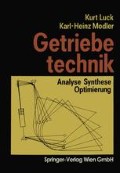Zusammenfassung
Zur rechnerischen Erfassung der ebenen Bewegung wird die Gausssche Zahlenebene zugrunde gelegt. Des weiteren werden E 1(M 1, x l, y l) als ruhende Ebene oder Rastebene sowie E 3(M 3, x 3, y 3) als bewegte Ebene oder Gangebene eingeführt; siehe Bild 3.1. Der Drehwinkel φ 31 gilt als Bewegungsparameter, was der Annahme einer gleichmäßigen Drehung φ 31 ~t gleichkommt.
Access this chapter
Tax calculation will be finalised at checkout
Purchases are for personal use only
Preview
Unable to display preview. Download preview PDF.
Author information
Authors and Affiliations
Rights and permissions
Copyright information
© 1990 Springer-Verlag Wien
About this chapter
Cite this chapter
Luck, K., Modler, KH. (1990). Grundlagen der ebenen Kinematik. In: Getriebetechnik. Springer, Vienna. https://doi.org/10.1007/978-3-7091-3889-2_3
Download citation
DOI: https://doi.org/10.1007/978-3-7091-3889-2_3
Publisher Name: Springer, Vienna
Print ISBN: 978-3-7091-3890-8
Online ISBN: 978-3-7091-3889-2
eBook Packages: Springer Book Archive

